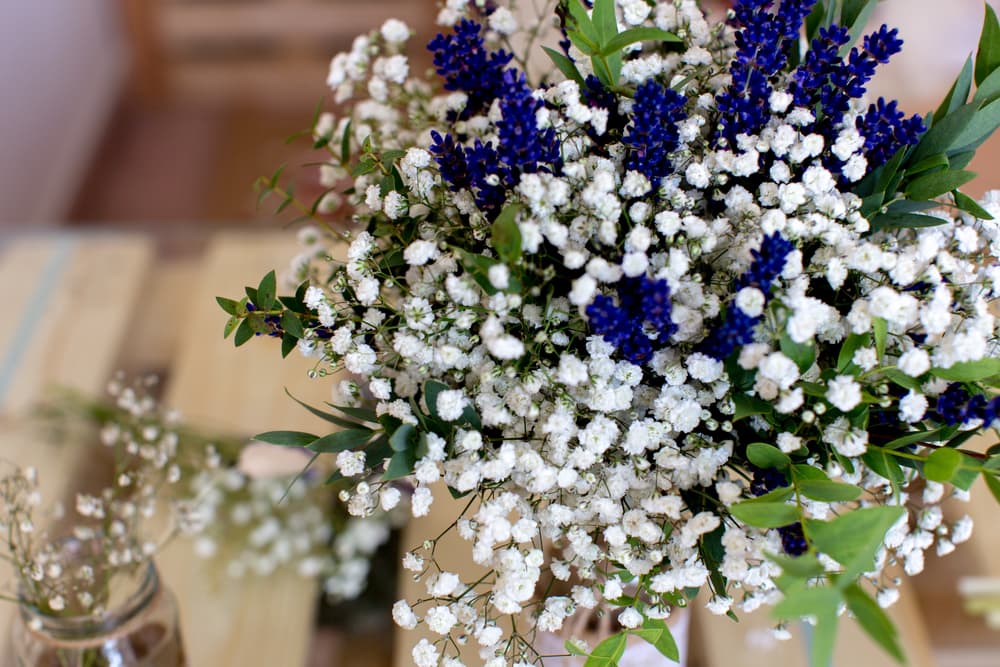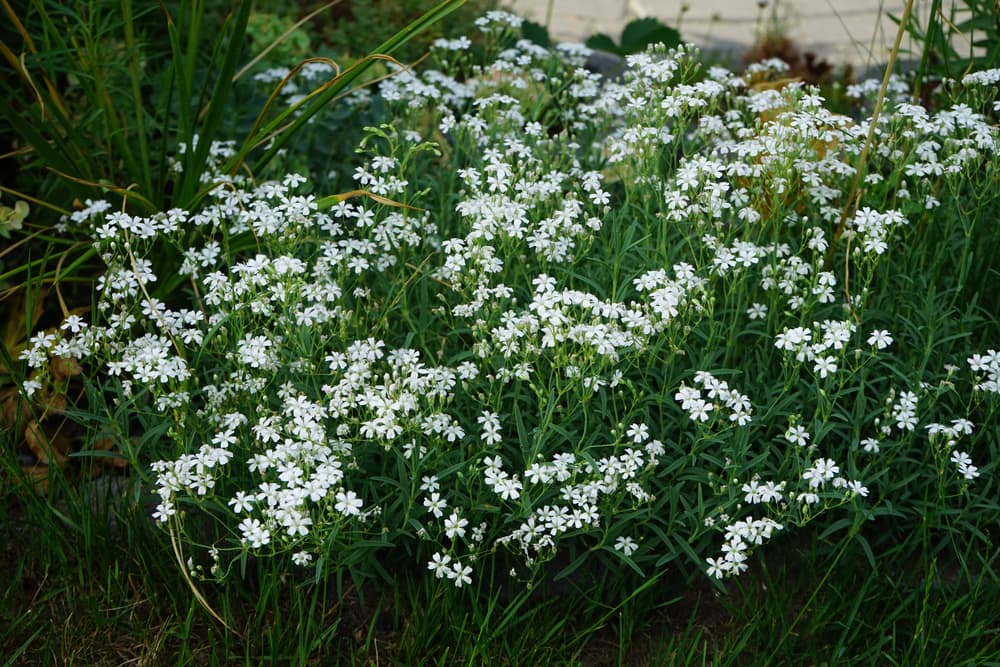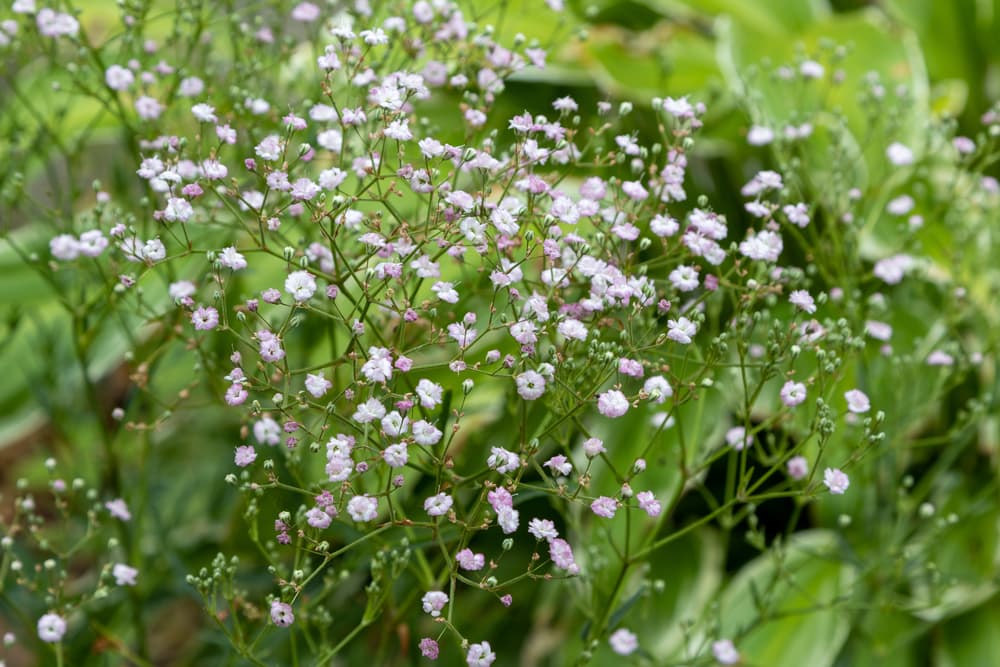How To Grow Gypsophila ‘Baby’s Breath’ – This Long-Lasting Filler Plant Will Grow Anywhere

PERENNIALS > GYPSOPHILA
Reviewed By COLIN SKELLY

Colin is a Horticulturist and Horticultural Consultant with experience in a range of practical and managerial roles across heritage, commercial and public horticulture. He holds the Royal Horticultural Society’s Master of Horticulture award and has a particular interest in horticultural ecology and naturalistic planting for habitat and climate resilience.
IN THIS GUIDE
GYPSOPHILA GUIDES
Those pretty billowing clouds in floral arrangements that we call “Baby’s Breath”, which set off roses and tulips, are actually tiny flowers of Gypsophila species and varieties.
Gypsophila is native to almost Eurasia; only India and a few countries southeast of it are uninhabited by these plants.1Gypsophila. (n.d.). Kew Royal Botanic Gardens. Retrieved March 16, 2023, from https://powo.science.kew.org/taxon/urn:lsid:ipni.org:names:6285-1
These plants are also native to South Africa and Northern Africa, and they have been introduced to the United Kingdom and United States, among other countries.
Overview
| Botanical Name | Gypsophila |
| Common Name(s) | Baby’s Breath |
| Plant Type | Perennial / Annual Flower |
| Native Area | Eurasia, Africa, Australia, Pacific Islands |
| Hardiness Rating | H7 |
| Foliage | Deciduous or evergreen |
| Flowers | Large sprays of delicate white flowers |
| When To Sow | March, April |
| Flowering Months | June, July, August |
| When To Prune | August, September |
Sunlight
Preferred
Full Sun
Exposure
Exposed
Size
Height
1 – 1.5M
Spread
0.5 – 1M
Bloom Time
June – August
Soil
Preferred
Chalk, loam
Moisture
Moist but well drained
pH
Neutral / Alkaline
Out of the about 150 species and several dozen cultivars that comprise Genus Gypsophila, several are well known to anyone who has received a bouquet and to most of those who have sent one.2The Editors of Encyclopaedia Britannica. (1998c, July 20). Baby’s Breath | Description, Species, & Facts. Encyclopedia Britannica. Retrieved March 16, 2023, from https://www.britannica.com/plant/babys-breath
These varieties are informally known as “Baby’s Breath”.
Gypsophila paniculata, a few other Gypsophila species, and their hybrids and cultivars make up “Baby’s Breath”. They are actually called ‘Gyp’ in the trade.
Though Baby’s Breath flowers are commonly called a ‘florist’s filler’, the tiny blossoms are indescribably pretty accompaniments to the carnations, gerberas, and such that form the centrepiece of a bouquet.

These dainty flowers are not of much importance individually but when massed, they give the effect of wavy, bubbly, billowing floral clouds out in the garden and even in a static floral arrangement.
A good mix of varieties will provide blooms from spring to end-autumn.
Each plant puts up a large number of delicate stalks which carry large panicles of five-petalled flowers.
Though all varieties’ flowers are very small, their sizes vary somewhat.

The colours are limited to white, off-white, yellowish, and tones of light pink-purple.
Some of the reasons for Baby’s Breath’s popularity and ubiquity in bouquets and arrangements include:
- Even the cut flowers are long-lasting.
- In the garden the flowers are a big draw for butterflies and bees.
- These flowers have a lovely scent.
Gypsophila is a herbaceous plant, and species and varieties are annual, evergreen, deciduous, or semi-deciduous.
Habitat & Growing Conditions
Habitat & Growing Conditions for Gypsophila species and particularly paniculata may be described as, ‘Anywhere and Everywhere’ to be concise, if not precise.
These plants grow and spread in gardens, fields, woods, roadsides, ditches, sandbanks, pastures – just so long as the soil is not acidic.
In this genus’s natural habitat, it grows on the steppes, in woodlands, on hillsides, by rural pathways, and in the poor, calcareous soils that are abundant in that region.

Gypsophila grows in all kinds of soils to the extent that it is classified as an invasive species in many geographic regions of the United States and also in other countries.3babysbreath: Gypsophila paniculata. (n.d.). Invasive Plant Atlas of the United States. Retrieved March 16, 2023, from https://www.invasiveplantatlas.org/subject.html?sub=5682
Almost all Baby’s Breath varieties are hardy to RHS Zone H7 – making them suitable to grow in all areas of the UK as perennials.
How To Grow Baby’s Breath
One might think that Baby’s Breath is not as widely available as popular plants, both perennials and annuals, but one would be wrong.
Almost all Baby’s Breath varieties, to a greater or lesser degree, are available as potted plants from nurseries, many of which will have the plants delivered to your doorstep.

Seed packets of some select varieties are also available.
Where To Grow
To be honest, Baby’s Breath is not a great plant for beds or containers though it is superlative for everything else.
That said, if you are a floral arranger or do ikebana, then – of course – you may very well want to grow Baby’s Breath in a bed or two in your garden.
It is ideal for texture and filler in the garden just the same as in floral arrangements, and is also an excellent choice for filling in gaps.
“Although it is very well known as a florist plant, Gypsophila is also fantastic as a garden plant,” shares Horticultural Consultant Colin Skelly.

“It can provide ground cover for a great space filler in borders or gravel gardens.
“I use it between more structural plants, providing a more finely textured backdrop.”
Not only is this ‘filler’ decorative, it somehow heightens the attractiveness of the specimens or centrepieces it surrounds or forms a backdrop to.
The creeping varieties make for lovely groundcover, and both creeping and dwarf varieties are terrific in rock gardens.
Baby’s Breath, along with small wildflowers, planted together will produce a charming, cottage garden effect.
Sowing & Planting
Sow Baby’s Breath seeds, of either perennial or annual types, in early spring in a sunny spot.
These plants should be well-spaced; a good rule of thumb is to space them apart by about 90% of the variety’s rated ultimate spread.
Once a plant is established it should not be transplanted or otherwise disturbed because of the thick and long taproot.
Plant Care
Full sun is best but partial shade will do; delicate varieties like ‘Flamingo’ should be sheltered.

Soil, Feeding & Watering
This plant does not take well to rich soils, fertilisation, or watering; where Baby’s Breath is concerned, ‘Less is more’.
Plant them in chalky, sandy, or gravelly soil that is, preferably, Slightly Alkaline (but not at all on the acidic side).
Water infrequently and fertilise sparingly only if necessary.

Soil should be well drained – Baby’s Breath is especially intolerant of damp soil in winter.
Pruning
Most varieties will produce a second bloom if the plant is conservatively cut back after the first flowering.
Common Problems
The plant is generally pest-free.
Stem Rot
Occasionally a plant may be affected by stem rot or botrytis AKA ‘grey mould’.
Stem rot is usually caused by bacteria.
It is hard to treat but you can guard against it by mulching around the stem before the onset of winter.
Botrytis
Botrytis is a fungal disease.
Promptly cut off the diseased parts or remove the entire plant if it is badly affected.
If ‘plant surgery’ is the route you take, apply Neem Oil on and around the parts of the plant that were cut, and sterilise your secateurs with a proprietary disinfectant or alcohol solution.
References
- 1Gypsophila. (n.d.). Kew Royal Botanic Gardens. Retrieved March 16, 2023, from https://powo.science.kew.org/taxon/urn:lsid:ipni.org:names:6285-1
- 2The Editors of Encyclopaedia Britannica. (1998c, July 20). Baby’s Breath | Description, Species, & Facts. Encyclopedia Britannica. Retrieved March 16, 2023, from https://www.britannica.com/plant/babys-breath
- 3babysbreath: Gypsophila paniculata. (n.d.). Invasive Plant Atlas of the United States. Retrieved March 16, 2023, from https://www.invasiveplantatlas.org/subject.html?sub=5682

